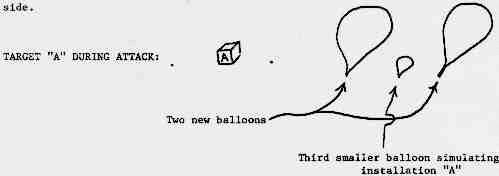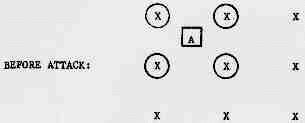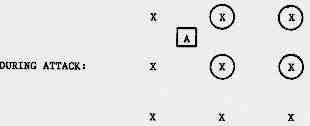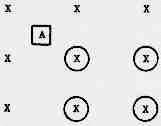
 Decoy defense letter to Harold Brown Jul 21/78
Decoy defense letter to Harold Brown Jul 21/78
| July 21, 1978 |
Perhaps the following is a viable defense against the cruise missile, or any missile relying on satellite-generated images of terrain features. The idea can be considered in a large number of variations, of which I will touch on only a few.
Suppose installation "A" is a probable target for cruise missile attack, and suppose that in the weeks or months prior to an attack, "A" is flanked by two (or more) large, radar-reflective balloons. Any updating of the missile's memory during this period, therefore, will incorporate the balloons.

When an attack is actually on its way, even one minute's warning should be enough to release these balloons, or puncture them, and to inflate similar balloons that are displaced a hundred meters (or whatever) to one side

2.
A variation on this defense might be to have no balloons until an attack was on its way, then inflate balloons in the path of the incoming missile which simulated prominant features of the real target area. This alternative is attractive because the size and delicacy of balloons opens them up, when deployed for long periods of time, to vandalism, sabotage, and high winds. To more closely resemble real features, balloons of different shapes might be considered.
A more elaborate variation of this defense would be to have hardened balloon dispensers which could inflate one balloon after another as needed, as at the points marked "X" below. Circled "X"s indicate inflated balloons.

At the signal of a first-wave attack, the pattern of inflated balloons would be shifted to one of the alternative locations, as below.

Balloons in the decoy position that were destroyed by the missile could be immediately replaced by the dispensers, and the pattern of deployment could be altered as often as was made necessary by altered instruction to incoming missiles. Optimally, the pattern would shift to the original one

3.
surrounding "A" except during actual attack. Also, a balloon simulating "A" itself could appear in the middle of each decoy square.Of course this defense would be more effective the fewer the geographical features that were too prominent to mask or simulate: a prairie or desert setting would be good; an ocean target, such as an oil-well platform, with balloons stored and released from the ocean floor, but anchored when at the surface, might be considered.
The balloons I have in mind are modelled after rapidly-inflating ones such as the "air bags" used to prevent injury in automobiles which inflate in 1/20 sec, or those tested as decoys against Syrian SAMs by the Israeli air force in April, 1974. The singular advantage of such balloons is that their extremely low cost as compared to either the target saved, the incoming missile wasted, or alternative defenses makes it economical to deploy and expend them in profligate numbers.
|
Yours truly, Lubomir S. Prytulak, Ph.D. Associate Professor |